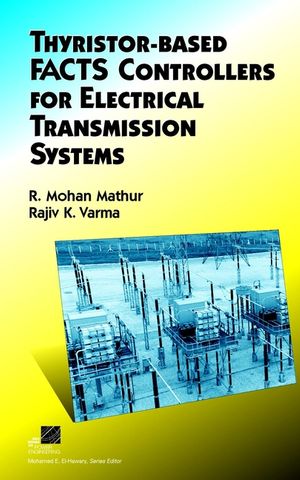Thyristor-Based FACTS Controllers for Electrical Transmission SystemsISBN: 978-0-471-20643-9
Hardcover
528 pages
February 2002, Wiley-IEEE Press
 This is a Print-on-Demand title. It will be printed specifically to fill your order. Please allow an additional 10-15 days delivery time. The book is not returnable.
|
||||||
1.1 Background.
1.2 Electrical Transmission Networks.
1.3 Conventional Control Mechanisms.
1.4 Flexible ac Transmission Systems (FACTS).
1.5 Emerging Transmission Networks.
2. Reactor-Power Control in Electrical Power Transmission Systems.
2.1 Reacrive Power.
2.2 Uncompensated Transmission Lines.
2.3 Passive Compensation.
2.4 Summary.
3. Principles of Conventional Reactive-Power Compensators.
3.1 Introduction.
3.2 Synchronous Condensers.
3.3 The Saturated Reactor (SR).
3.4 The Thyristor-Controlled Reactor (TCR).
3.5 The Thyristor-Controlled Transformer (TCT).
3.6 The Fixed Capacitor-Thyristor-Controlled Reactor (FC-TCR).
3.7 The Mechanically Switched Capacitor-Thristor-Controlled Reactor (MSC-TCR).
3.8 The Thyristor-Switched capacitor and Reactor.
3.9 The Thyristor-Switched capacitor-Thyristor-Controlled Reactor (TSC-TCR).
3.10 A Comparison of Different SVCs.
3.11 Summary.
4. SVC Control Components and Models.
4.1 Introduction
4.2 Measurement Systems.
4.3 The Voltage Regulator.
4.4 Gate-Pulse Generation.
4.5 The Synchronizing System.
4.6 Additional Control and Protection Functions.
4.7 Modeling of SVC for Power-System Studies.
4.8 Summary.
5. Conceepts of SVC Voltage Control.
5.1 Introduction
5.2 Voltage Control.
5.3 Effect of Network Resonances on the Controller Response.
5.4 The 2nd Harmonic Interaction Between the SVC and ac Network.
5.5 Application of the SVC to Series-Compensated ac Systems.
5.6 3rd Harmonic Distortion.
5.7 Voltage-Controlled Design Studies.
5.8 Summary.
6. Applications.
6.1 Introduction.
6.2 Increase in Steady-State Power-Transfer Capacity.
6.3 Enhancement of Transient Stability.
6.4 Augmentation of Power-System Damping.
6.5 SVC Mitigation of Subsychronous Resonance (SSR).
6.6 Prevention of Voltage Instability.
6.7 Improvement of HVDC Link Performance.
6.8 Summary.
7. The Thyristor-Controlled SeriesCapacitor (TCSC).
7.1 Series Compensation.
7.2 The TCSC Controller.
7.3 Operation of the TCSC.
7.4 The TSSC.
7.5 Analysis of the TCSC.
7.6 Capability Characteristics.
7.7 Harmonic Performance.
7.8 Losses.
7.9 Response of the TCSC.
7.10 Modeling of the TCSC.
7.11 Summary.
8. TCSC Applications.
8.1 Introduction.
8.2 Open-Loop Control.
8.3 Closed-Loop Control.
8.4 Improvement of the System-Stability Limit.
8.5 Enhancement of System Damping.
8.6 Subsynchronous Resonanace (SSR) Mitigation.
8.7 Voltage-Collapse Prevention.
8.8 TCSC Installations.
8.9 Summary.
9. Coordination of FACTS Controllers.
9.1 Introduction
9.2 Controller Interactions.
9.3 SVC-SVC Interaction.
9.4 SVC-HVDC Interaction.
9.5 SVC-TCSC Interaction.
9.6 TCSC-TCSC Interaction.
9.7 Performance Criteria for Damping-Controller Design.
9.8 Coordination of Multiple Controllers Using Linear-Control Techniques.
9.9 Coordination of Multiple Controllers using Nonlinear-Control Techniques.
9.10 Summary.
10. Emerging FACTS Controllers.
10.1 Introduction.
10.2 The STATCOM.
10.3 THE SSSC.
10.4 The UPFC.
10.5 Comparative Evaluation of Different FACTS Controllers.
10.6 Future Direction of FACTS Technology.
10.7 Summary.
Appendix A. Design of an SVC Voltage Regulator.
A.1 Study System.
A.2 Method of System Gain.
A.3 Elgen Value Analysis.
A.4 Simulator Studies.
A.5 A Comparison of Physical Simulator results With Analytical and Digital Simulator Results Using Linearized Models.
Appendix B. Transient-Stability Enhancement in a Midpoint SVC-Compensated SMIB System.
Appendix C. Approximate Multimodal decomposition Method for the Design of FACTS Controllers.
C.1 Introduction.
C.2 Modal Analysis of the ith Swing Mode,
C.3 Implications of Different Transfer Functions.
C.4 Design of the Damping Controller.
Appendix D. FACTS Terms and Definitions.
Index.



